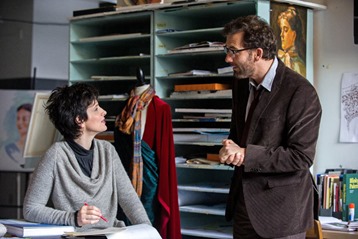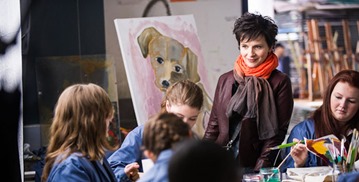An alcoholic English teacher faces off against a partially disabled artist in a challenge to discover which is more powerful – a piece of art, or a piece of prose or poetry. Clive Owen and Juliette Binoche play the agreeably disagreeable pair as they set out to win their students to their respective views.
Jack Marcus (Owen) is an alcoholic English teacher whose job may be in jeopardy, while the annual magazine he publishes for the school is definitely a goner. Dina Delsanto (Binoche) is the tortured artist who has been unable to create any new work because of her advanced rheumatoid arthritis.
At her introduction as an artist at the elite prep school where they teach, Jack, after a quick onceover, responds, ‘Hence the scarf.’ When he is introduced as the English teacher, she comes back with, ‘Hence the hence.’
Marcus is the kind of teacher who will read from the works of the greats, and figuratively speaking, paint pictures with language that inspires his students. He is bombastic, energetic and idealistic – in class. At home, he drinks too much and spends a lot his free time semi-comatose.
Delsanto is as icy as Marcus is fiery. She recognizes talent but is less florid in her teaching style. Her nicknames usually have something to do with cold – though she does find something noteworthy in the art of one student, Emily (Valerie Tian) and prompts her to do even better (‘encourages’ would be entirely too kind a word).
As part of his hazing of Delsanto, he engages her in a vocabulary game requiring words of more and more syllables. This leads to sparkage – clearly seen by colleague, Walt (Bruce Davison) – even if they can’t see it themselves (Walt gives Delsanto a ten-syllable word he’s been holding in reserve).
Finally, Marcus comes up with a competition between his Honors English class and Delsantos’ Honors Art class – her class will paint pictures and his class will write something about them. All he has to do is get his students to pry themselves from their iPhones, iPads, and such.
Oddly enough, the students are poked into participating as art and words installations in the school showcase quickly become compelling – leading to the inevitable final clash at the end of the semester.
Written by Gerald Di Pego, Words and Pictures takes a shot at a story we’ve seen before – two opposites attracting, parting, discovering that they might not be such opposites after all and coming together. On one hand, there’s nothing new here; on the other, you have the unlikeliest of couples – physically, Owen could practically wrap one hand around Binoche’s heat (!); temperamentally, he’s fiery and mercurial while she’s cool and consistent – but they each have a passion for work and a desire for their students to do something with themselves beyond playing Angry Birds and sexting.
Director Fred Schepisi (Roxanne, Mr. Baseball, I.Q.) is quick to show his characters’ flaws, but teasingly draws out revelations of their strong suits beyond their obvious passions. Somehow, he takes the 1500-piece puzzle that is the mix of fiery Marcus and cold Delsanto, and puts them together properly – mixing and matching colors and tones and moods in exactly the right way – by not forcing the pace; by letting supporting characters have their moments in ways that offset the presence of the main duo, and by keeping on the right side of the line in terms of balancing restraint and bombast.
There might not be anything new about Words and Pictures – the key debate has been going on since early humans painted pictures of their exploits on cave walls – but there is a freshness provide through ingenious casting and allowing the character moments of the film grow in their own time.
It may not be Shakespeare, but it’s not Jackie Collins, either – and it’s certainly a breath of fresh air in the midst of the waves of summer blockbusters.
Final Grade: B
Photos courtesy of Roadside Attractions


